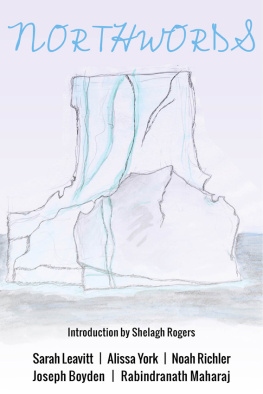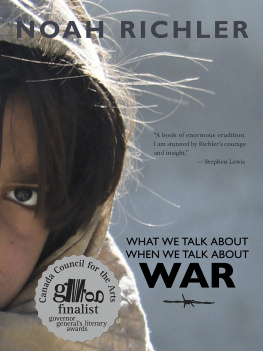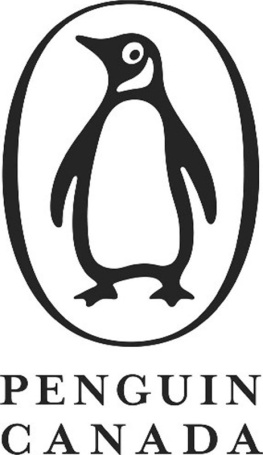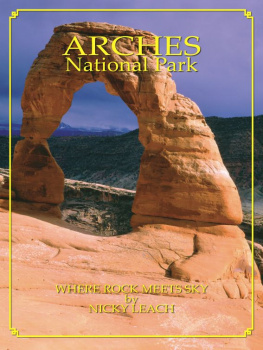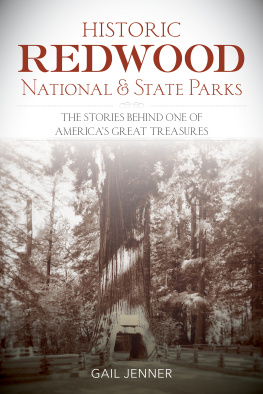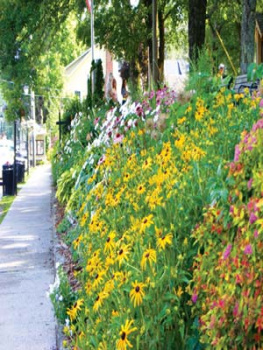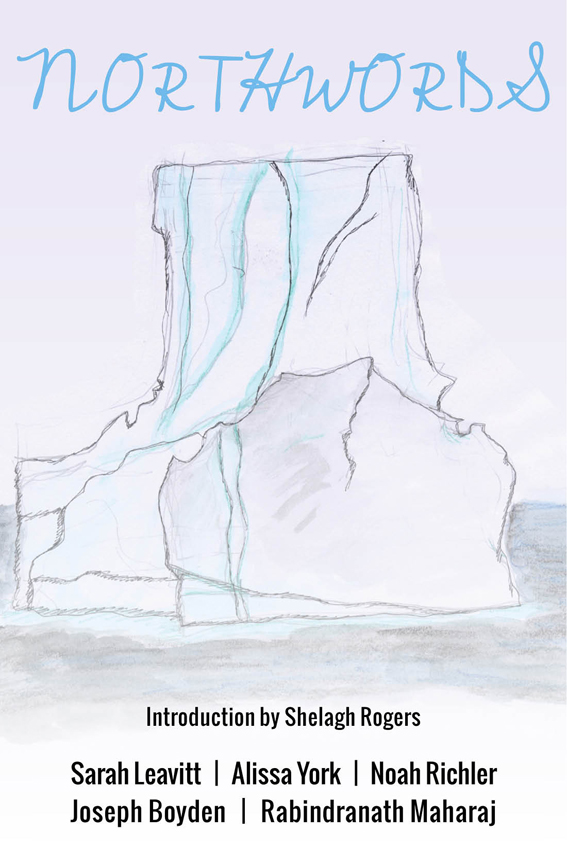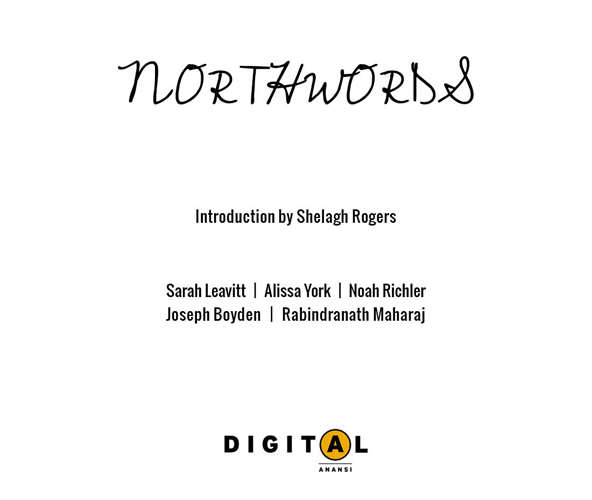
Proceeds from the sale of this ebook will benefit
Peter Gzowskis PGIs for Literacy charity
Copyright 2011 Joseph Boyden, Sarah Leavitt,
Rabindranth Maharaj, Noah Richler, and Alissa York
Introduction copyright 2012 Shelagh Rogers
All rights reserved. No part of this publication may be reproduced or transmitted in any form or by any means, electronic or mechanical, including photocopying, recording, or any information storage and retrieval system, without permission in writing from the publisher.
Distribution of this electronic edition via the Internet or any other means without the permission of the publisher is illegal. Please do not participate in electronic piracy of copyrighted material; purchase only authorized electronic editions. We appreciate your support of the authors rights.
This edition published in 2012 by
House of Anansi Press Inc.
110 Spadina Avenue, Suite 801
Toronto, ON, M5V 2K4
Tel. 416-363-4343
Fax 416-363-1017
www.houseofanansi.com
ISBN 978-1-77089-339-9
Cover and ebook design: Erin Mallory
Cover illustration: Sarah Leavitt
All photographs Joel McConvey

We acknowledge for their financial support of our publishing program the Canada Council for the Arts, the Ontario Arts Council, and the Government of Canada through the Canada Book Fund.
____________
Produced in cooperation with www.filmcan.org

These stories were written as part of a project called Northwords, which saw the broadcast-journalist Shelagh Rogers take a group of five writers to Torngat Mountains National Park. A documentary crew filmed the writers, and Shelagh interviewed them in this breathtaking setting. She challenged each of them to write a new story responding to the land and their experiences there.
For more information about the Northwords project and to connect with the projects interactive website, go to www.northwordscanada.ca.
INTRODUCTION
By Shelagh Rogers
The e-book before you had very watery beginnings. In the summer of 2010, I was swimming in Bonne Bay, Gros Morne National Park, with my friend Jeff Anderson. Jeff is the Superintendent for the national parks of Western Newfoundland and Labrador. As we were treading water, Jeff talked about how 2011 was the centenary of Canadas national parks service, the very first national parks service in the world, and he asked me what idea I might have for a celebration. Well, I said, what if we take a group of authors who live in big cities, and smuggle them off to the wilderness for a week. Wed make them write a new story responding to the land and their experiences there...follow them around with a recorder and, well, I could make a radio documentary about what triggers the creative process. This was just off the top of my head and I confess to blowing a bit of smoke. But Jeff said, Shelagh, I know just the place.
That November, I met another Jeff, though he spelled his name Geoff, in another national park. Banff was celebrating its 125th anniversary and I was hosting a panel on arts in the park. One of the panelists was Geoff Morrison, a filmmaker whose work is very much about the power of place. He had curated The National Parks Project, which dispatched musicians to 13 national parks and to be filmed by 13 individual directors. I told Geoff about the idea of taking urban writers to a faraway park and letting them loose on the land as they let the land loose on their imagination. He was intrigued. Emails went back and forth to Parks Canada and, with help of the visionary Andrew Campbell, Director General, External Relations and Visitor Experience Directorate of Parks Canada (he has a very large business card), we had lift-off.
Our destination turned out to be a place I had visited, briefly, once before: Torngat Mountains National Park. Its located on that most northern point where Quebec meets Labrador, extending from the Quebec border eastward to the Labrador Sea, covering some 9700 square kilometers. It is a sacred place for the Labrador Inuit who, in fact, co-manage the park with Parks Canada in a mutually respectful partnership, and its home to seal, Arctic char, the George River caribou herd, and polar bears.
I wrote to five writers inviting them to take part in this literary experiment. First, there was the New Orleans/Toronto writer Joseph Boyden, Scotiabank Giller Prize winner for his novel, Through Black Spruce . He wrote back and said You had me at Dear...! Of course!!!! Cant wait. Sarah Leavitt of Vancouver is the creator of a powerful graphic memoir called Tangles: A Story About Alzheimers, My Mother and Me . I am almost throwing up from excitement. she wrote. And I looked at photos of the park and started crying. I asked Noah Richler, author of This is My Country, Whats Yours? , knowing it would cut into cherished time he spends each summer away from Toronto in Digby Neck, Nova Scotia. But he replied Count me in. Then there was Alissa York whom I had only met once for an interview about her novel Fauna . But I felt a strong connection. Her response was Good lord, of course Id love to take part in the great Torngat Mountains pilgrimage! Sign me up! Will sign off now before I wear out the exclamation point on my keyboard! The fifth writer was someone I had taken for his very first canoe ride: the Trinidad-born Ajax, Ontario writer Rabindranath Maharaj. He is the author of The Amazing Absorbing Boy , winner of the 2011 Trillium book award. He said I think it will be a great trip and I am certainly prepared to go. I will spend 2 weeks meditating to make my body impervious to all pain.
I think fear and the possibility of pain were in the back of all our minds. Certainly they surfaced in mine. This is the true north, not cottage country. It is remote. There is danger (there was a waiver all park visitors had to sign acknowledging the things that could happen and this waiver would inspire Noah Richlers essay). We would be staying in tents, there would be no wifi, and if the camp ran out of food, which it did, wed be going out on the land (with Inuit hunters) to get it, which we did.
Traveling the great expanse of this country, I have often felt that Canada could do with a bit of editing. It took two and a half days to get to Happy Valley Goose Bay, Labrador from my home on a gulf island in BC. And there were still two planes and a longliner to catch before arriving at Kangidluasik, our base camp at the edge of the park. It was a scattering of tents clustered around a building, which housed a research station and dining hall. This tent city was ringed by an electric fence designed to keep us in and polar bears out. Us were park staff, cooks, geologists visiting from Japan, biologists, botanists, glaciologists, other kinds of -ists, Inuit teenagers from Northern Quebec and Labrador, Inuit Elders, some tourists, some teachers from Newfoundland, and some students from the United States.
Add to that five authors who had seven days to create new work. In that week, we camped out, hiked, fished, and joined in a hunt (always under the protection of our armed Inuit bear guardsthere wasnt a moment I didnt feel safe). I interrupted the writers writing, and recorded their thoughts for radio as they wrote new pieces of fiction and non-fiction. I caught them in the creative act, so to speak, and all the while, Geoff Morrisons crew filmed us.

